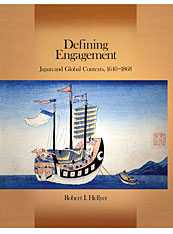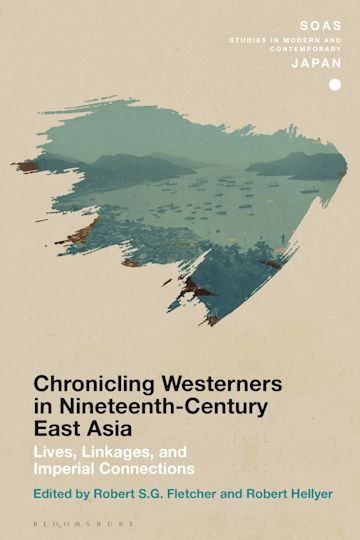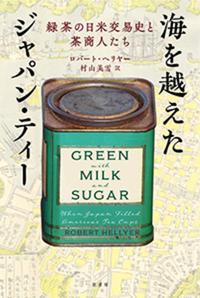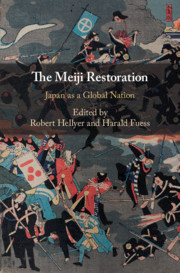Bio
Robert Hellyer grew up in Tacoma, Washington and first developed an interest in Japanese history while teaching in Yamaguchi prefecture as a member of the Japan Exchange and Teaching Program. He later served on the faculty of The University of Tokyo, taught at Allegheny College, and was a postdoctoral fellow at the Reischauer Institute of Japanese Studies at Harvard University before coming to Wake Forest.
He teaches courses on Japan, East Asia, and world social and economic history. In addition, he has worked with Wake Forest alumni who majored in History to identify ways to highlight the professional skills gained in undergraduate History courses, strategies detailed in an article in The History Teacher.
A historian of early modern and modern Japan, Professor Hellyer has explored foreign relations from the seventeenth to the nineteenth centuries, research presented in a monograph, Defining Engagement: Japan and Global Contexts, 1640-1868 (Harvard University Asia Center, 2009) and in several journal articles and book chapters. He also researched Japan’s role in the global tea trade of the late nineteenth and early twentieth centuries, a project for which he received Smithsonian, Japan Foundation, Hakuhodo Foundation, Sainsbury Institute, and NEH fellowships to support research in Britain, Japan and the United States. That research culminated in the monograph, Green with Milk and Sugar: When Japan Filled America’s Tea Cups. Columbia University Press, 2021.
In addition, he co-organized a multi-year research project involving historians in North America, Europe, Japan, and East Asia that examined Japan’s Meiji Restoration in advance of the 150-year anniversary in 2018 which resulted in several articles and Robert Hellyer and Harald Fuess, eds., The Meiji Restoration: Japan as a Global Nation. Cambridge University Press, 2020.
He also co-edited, with Robert Fletcher, Chronicling Westerners in Nineteenth-Century East Asia: Lives, Linkages, and Imperial Connections. SOAS Studies in Modern and Contemporary Japan. Bloomsbury, 2022.
Background
Education
B.A. Claremont McKenna College
M.A. Stanford University
Ph.D. Stanford University
Academic Appointments
Wake Forest University, Assistant Professor of History (2005-2011), Associate Professor (2011-2021), Professor (2022- ); Coordinator of East Asian Studies Interdisciplinary Minor (2013-2023)
Allegheny College, Assistant Professor of History (2001-2005)
Keio University, Visiting Assistant Professor, Faculty of Economics (June 2009-January 2010)
University of Tokyo, Faculty Research Associate (assistant professor) (1998-2000)
Research Fellowships & Positions
Visiting Fellow, International Research Center for Japanese Studies (Nichibunken) (July 2017 to August 2o18)
Robert and Lisa Sainsbury Fellow, Sainsbury Institute for the Study of Japanese Arts and Cultures (Summer 2014)
National Endowment for the Humanities Fellow, Newberry Library, Chicago (August 2012-August 2013)
Visiting Researcher, Graduate School of Interdisciplinary Information Studies, University of Tokyo (Summer 2011)
Visiting Researcher (Japan Foundation Fellow), Historiographical Institute, University of Tokyo (August 2007-August 2008)
Postdoctoral Fellow, Freer & Sackler Galleries and National Museum of American History, Smithsonian Institution (Summer 2007)
Postdoctoral Fellow, Reischauer Institute of Japanese Studies, Harvard University (September 2004-June 2005)
- HST 109 Asia and the World
The course explores how East Asia, chiefly China, Japan and Korea, have interacted with the outside world from 1500 to the present. It considers East Asian views of Europe and the US, the nature of early modern commercial and diplomatic relations, the adoption of new technologies and Christianity in East Asia, East Asian “modernization” in the nineteenth and twentieth centuries, WWII in East Asia, communism and socialism, and rapid economic development in the region since WWII. - HST 246 Japan before 1600
This course surveys Japan from earliest times to the coming of Western imperialism, with emphasis on regional ecologies, economic institutions, cultural practice, military organization, political ideology, and foreign relations. - HST 247 Japan since 1600
This course surveys Japan in the modern world. Topics include political and cultural revolution, state and empire-building, economic “miracles,” social transformations, military conflicts, and intellectual dilemmas. - HST 249 Introduction to East Asia
This course is an introduction to the histories and cultures of East Asia, from the earliest times to the present, focusing on China, Korea, Japan, and Vietnam, with some attention to the rest of South-East Asia and emphasizing ecology and economy, trade and international relations, political ideology, religious belief, and cultural practice. - HST 347 The Rise of Asian Economic Power since WWII. (3h) At the end of WWII, Japan, South Korea, and China faced economies ravaged by war. Yet within a few decades, all experienced high-speed economic growth and became some the world’s most dynamic economies. This course will examine the process of economic development in all three nations, paying particular attention to business practices, foreign trade, government and bureaucratic involvement in economic growth, and consumer and labor markets. It will also explore how the three nations have confronted recent challenges of national debt, increasing international competition, and aging societies.
- HST 348 Samurai and Geisha: Fact, Film, and Fiction
This course focuses on two well-known groups in Japanese history, the samurai (warriors) and geisha (entertainers). By analyzing historical studies and primary sources, as well as works of fiction and films about samurai and geisha, the course considers how Japanese and Western historians, novelists, and filmmakers have portrayed the two groups and by implication Japan and its history in the modern period. - HST 350 World Economic History: Globalization, Wealth and Poverty since 1500
This course explores the growth of globalization and its role in the creation of wealth and poverty in both developed and underdeveloped nations. The class focuses on trade, industrialization, and agricultural and technological advances in global contexts. - HST 390 World War II, War Crimes and US Law
After World War II, the United States and its allies tried and punished German and Japanese for war crimes, thereby establishing new precedents for international and American law. This seminar will explore the war crimes trials for prominent German and Japanese leaders—in Nuremberg and Tokyo—as well as those held for lower ranking political and military officials. It will then examine several specific legal cases which involved Japanese defendants seeking redress in US courts and the US laws passed in response to the use of military tribunals to prosecute some war criminals. The course will conclude with an examination of how in the prosecution of accused terrorism suspects since 2001, the US government has revised and/or reaffirmed the laws and precedents established after WW II. Students will be invited to research in detail a topic related to the course theme and prepare an extended essay. Students interested in law school or a legal career may find the course particularly valuable.
Green with Milk and Sugar-When Japan Filled America’s Tea Cups. Columbia University Press, 2021. Japanese translation: 『海を越えたジャパン・ティー:緑茶の日米交易史と茶商人たち』Tokyo: Hara-shobo, 2022.
Robert Fletcher and Robert Hellyer, eds. Westerners in Nineteenth-Century East Asia: Lives, Linkages and Imperial Connections. SOAS Studies in Modern and Contemporary Japan. Bloomsbury, 2022.
Robert Hellyer and Harald Fuess, eds., The Meiji Restoration: Japan as a Global Nation. Cambridge University Press, 2020.
Defining Engagement: Japan and Global Contexts, 1640-1868. Harvard University Asia Center, 2009.




- “Foreign Relations and Coastal Defense under the Mature Tokugawa Regime,” in David Howell, ed., The New Cambridge History of Japan, Volume II: Early Modern Japan in Asia and the World, c. 1580–1877. Cambridge University Press, 2024, pp. 159-183.
- “Early Modern Japan: A State with Limited Migration,” in Catia Antunes and Eric Tagliacozzo, eds. The Cambridge History of Global Migrations, Volume 1. Cambridge Univ. Press, 2023, pp. 179-196.
- “世界茶市場と長崎のお茶”前田 拓 編、姫野順一 監修「抹茶革命と長崎」長崎文献社、2023年、149-151頁.
- “Local Labour and the Trajectory of the Meiji Restoration” in Timothy Amos and Akiko Ishii, eds. Revisiting Japan’s Restoration New Approaches to the Study of the Meiji Transformation, Routledge 2022, pp 26-32.
- “Imai Nobuo: A Tokugawa Stalwart’s Path from the Boshin War to Personal Reinvention in the Meiji Nation-State,” in Robert Hellyer and Harald Fuess eds. The Meiji Restoration: Japan as a Global Nation. Cambridge University Press, 2020, pp. 171-188.
- “Quality as a Moving Target: Japanese Tea, Consumer Preference, and Federal Regulation on the US Market,” in Kazuko Furuta and Linda Grove eds. Imitation, Counterfeiting and the Quality of Goods in Modern Asian History. Springer, 2017, pp. 93-106.
- “On the Dining Car, in the Station Restaurant, and from the Platform Peddler: Tea on Railways in the United States and Japan, 1860-1960,” in Jean-Pierre Williot ed. Railway Catering Between Imaginary and Consumption: Consumers, Images and Markets. Peter Lang, 2017, pp. 267-282.
- “1874: Tea and Japan’s New Trading Regime,” in Helen Siu, Peter Perdue, and Eric Tagliacozzo eds. Asia Inside Out: Trading Empires of the South China Coast, South Asia, & the Gulf Region Volume 1: Critical Times. Harvard University Press, 2015, pp. 186-206.
- Mid Nineteenth-Century Nagasaki: Western and Japanese Merchant Communities within Commercial and Political Transitions,” in Yuju Lin and Madeleine Zelin eds. Merchant Communities in Asia, 1600-1980. Pickering and Chatto, 2014, pp. 159-176.
- “Poor but Not Pirates: The Tsushima Domain and Foreign Relations in Early Modern Japan,” in Robert Antony ed. Elusive Pirates, Pervasive Smugglers: Violence and Clandestine Trade in the Greater China Seas. Hong Kong University Press, 2010, pp. 115-126.
- 「太平洋における日本―近世後期の対外貿易」浪川健治、デービッド・ハウエル、河西英通編『周辺史から全体史へ―地域と文化』清文堂 2009年、126-148頁。
- Articles in Conference Proceedings/ Contributions to Research Reports
- “Characteristics of Societal Competitiveness: Perspectives from the Japanese Experience.”Case Study Contributed to Michael J. Mazarr, The Societal Foundations of National Competitiveness, Rand Corporation, 2022.
- “Dueling Tea Rooms: Japan versus Britain for the US Market at International Exhibitions” in Sano Mayuko ed. Expos and Human History, International Research Symposium Proceedings no. 48, International Research Center for Japanese Studies [Nichibunken] November 2017, pp. 99-108.
- “中国から学び西洋に売り込む: 文明開化における中国のノウハウ” 細川周平, 山田奨治, 佐野真由子 編 「新領域・次世代の日本研究, 海外シンポジウム報告書 2014年] 国際日本文化研究センター 2016年11月、129-136頁.
- “幕末における対馬藩―弱小な藩の視点からの外圧:海防、対外関係の中での位置づけ” 東京大学史料編纂所編、「前近代日本史料の構造と情報資源化の研究」2000年度―2004年度,文部科学省、科学研究費補助金、特別推進研究(COE)研究成果報告書」2005年、541-548頁.
- “Foreign Trade in Tokugawa Japan.” Oxford Research Encyclopedia of Asian History (online), (May 2024): 1-19.
- Robert Hellyer and David Leheny, “Meiji at 150: A Global Moment for Japan Studies, an Ambivalent Moment in Japan” Journal of Japanese Studies, vol. 49, no. 1 (Winter 2023): 117-139.
- “The Meiji Restoration as a Local Event—The Second Kiheitai in History and Memory” Japanese Studies, Special Issue on the Meiji Restoration at 150 vol. 38, no. 3 (December 2018): 343-362.
- “Marrying Content and Practice: Raising Undergraduate Awareness of ‘Job Skill’ Acquisition in a History Survey Course,” The History Teacher vol. 52 no. 1 (November 2018): 77-88.
- “The West, the East, and the Insular Middle: Trading Systems, Demand, and Labour in the Integration of the Pacific, 1750-1875,” Journal of Global History 8.3 (November 2013): 391-413.
- “The Missing Pirate and the Pervasive Smuggler: Regional Agency in Coastal Defense, Trade, and Foreign Relations in 19th-century Japan,” International History Review 27.1 (March 2005): 1-24.
- “Intra-Asian Trade and the Bakumatsu Crisis: Reconsidering Tokugawa Commercial Policies in Late Edo Japan,” International Journal of Asian Studies 2.1 (January 2005): 83-110.
For a complete list of publications, see my CV.

